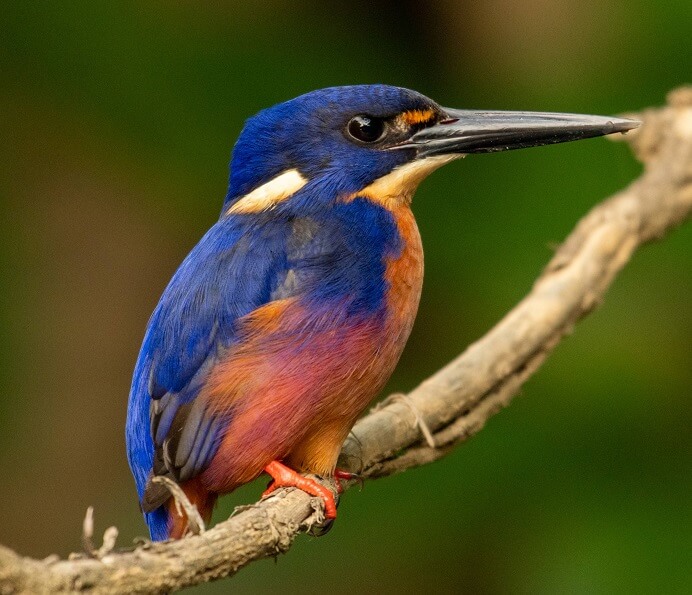

The Azure Kingfisher (Ceyx azureus) is a stunning bird species found in various habitats throughout Australia, including South East Queensland. Birdwatching the Azure Kingfisher at Murphys Creek Escape can be a rewarding and exciting experience. The diverse habitats and tranquil waterways of the park create an ideal environment for spotting these stunning birds. Remember, birdwatching is a patient and immersive experience. While the Azure Kingfisher is a sought-after species, the joy lies not only in spotting the bird but also in appreciating the surrounding natural environment and the diversity of avian life at Murphys Creek Escape.

Overview of the Azure Kingfisher
- Size: Azure Kingfishers are small birds, measuring about 13 to 17 centimeters (5 to 7 inches) in length from beak to tail.
- Weight: The average weight of Azure Kingfishers is approximately 25 to 40 grams (0.9 to 1.4 ounces).
- Plumage: Azure Kingfishers have striking plumage. The upperparts, including the head, back, and wings, are a vibrant, iridescent blue color. The underparts are predominantly white, with a slight tinge of blue on the breast. They also feature a white spot or patch of feathers near the base of the beak.
- Bill: Azure Kingfishers have a long, slender, and black-colored bill. The bill is pointed and sharp, ideal for catching small aquatic prey.
- Wingspan: Azure Kingfishers have relatively short wings compared to their body size. Their wingspan typically ranges from 20 to 24 centimeters (8 to 9.5 inches).
- Lifespan: The average lifespan of Azure Kingfishers in the wild is estimated to be around 6 to 8 years. However, with favorable conditions and minimal threats, some individuals may live longer.
- Vocalizations: Azure Kingfishers have a range of calls, including a distinctive high-pitched whistle or trill. They use vocalizations for territorial communication, courtship displays, and general communication with their mates or offspring.
Appearance
The Azure Kingfisher is a small, vibrant bird with brilliant blue and orange plumage. It has a compact body, measuring about 17-19 centimeters in length. The upperparts, including the head, back, and wings, are rich blue, while the underparts are white. It has a long, slender bill that is black in color.
Habitat
Begin your birdwatching adventure by exploring the water bodies within Murphys Creek Escape. Azure Kingfishers inhabit a range of freshwater habitats, including rivers, creeks, lakes, ponds, and wetlands. They prefer areas with overhanging vegetation or branches near water, where they can perch and dive to catch their prey. Identify strategic vantage points along the waterways where you can patiently observe and wait for Azure Kingfishers to make an appearance. Look for clear views of the water, preferably with a good line of sight to potential perches.
Behavior
These kingfishers are highly skilled at fishing. They have excellent eyesight and patiently watch for movement in the water. Once they spot a small fish or aquatic invertebrate, they dive swiftly, often with a distinctive splash, to snatch their prey. After catching their food, they return to a perch to consume it. Listen for their distinct calls, which can sometimes alert you to their presence.
Early morning and late afternoon are generally the best times to spot Azure Kingfishers. These birds are active throughout the day, but they tend to be more active during these periods. Their vibrant blue plumage stands out against the natural surroundings, making them easier to spot.
Diet
The diet of Azure Kingfishers consists primarily of small fish, crustaceans, insects, and aquatic invertebrates. They rely on their keen vision and hunting prowess to locate and capture their prey underwater.
Breeding
Azure Kingfishers breed during the warmer months of the year, typically from September to February. They excavate burrows in sandy banks near water bodies, creating nesting tunnels where they lay their eggs. Both male and female Azure Kingfishers participate in digging the burrow and raising the chicks.
Conservation Status
The Azure Kingfisher is not currently listed as a threatened species. However, like many bird species, it faces various threats such as habitat degradation, pollution, and disturbance. Protecting their freshwater habitats and preserving the quality of waterways is crucial for their continued survival.
South East Queensland offers suitable habitats for Azure Kingfishers, with its network of rivers, creeks, and wetlands. To spot these stunning birds, look for them perched on branches near the water’s edge. Their vibrant blue coloration makes them a striking sight against the lush green vegetation and sparkling water.
Camping and Birdwatching
Combining bush camping with birdwatching at Murphys Creek Escape allows you to fully immerse yourself in the natural wonders of the park while enjoying the beauty of Azure Kingfishers and other bird species. Remember, when observing Azure Kingfishers or any other wildlife, it’s important to maintain a respectful distance and minimize disturbances to their natural behavior. Enjoy the beauty of these birds and the diverse ecosystems of South East Queensland as you appreciate the presence of the Azure Kingfisher in the region.
Read More: Birdwatching near Toowoomba at Murphys Creek Escape
